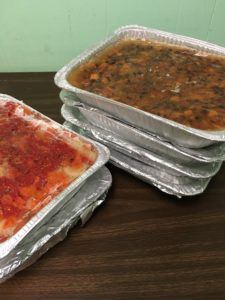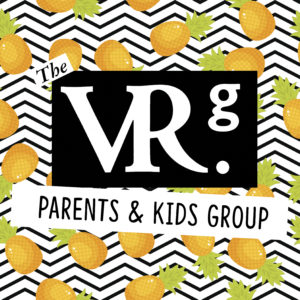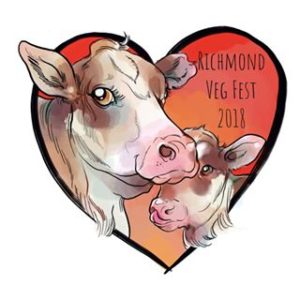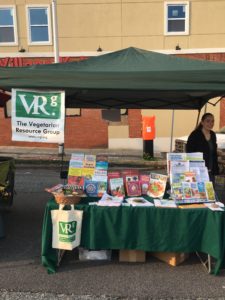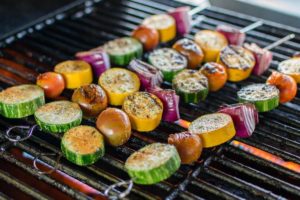Posted on
June 26, 2018 by
The VRG Blog Editor
By Hannah Greene, VRG Intern
For many people in inner-city communities, vegetarianism seems like it is simply not an option. A lot of neighborhoods have never been exposed to any sort of vegetarian restaurant, and people have rarely ever interacted with the concept. Vegetarianism is particularly foreign to classmates who grow up in inner-city communities and neighborhoods known as food deserts. In these areas, fast food is the primary option, so meals are dominated by meat. Many students at my school come from such communities, and to them vegetarianism seems like an impossible lifestyle. In order to build nutritional equity, I began a Vegetarian Support Group at my school. Through this club, I tried to show that vegetarianism is a feasible option for better health, a more compassionate lifestyle, and environmental preservation, without being too expensive or time-consuming.
Many of my peers had never considered adopting a meatless diet. Even my closest friends have a prejudice against veganism, so it is sometimes challenging to maintain my own lifestyle among their attitudes. Some think of vegetarianism solely as a form of self-deprivation, and this is a barrier in opening the minds of members of my school community.
To raise awareness about veganism and vegetarianism, I plastered school walls with dozens of eye-catching posters I had designed. Some posters featured surprising statistics, while others included colorful images of popular snacks and fast foods which happen to be vegan. I wrote morning announcements with information about the impacts of a vegetarian diet, appealing to the science and math enthusiasts who comprise my school, Baltimore Polytechnic Institute. Through these, I attracted people of all different backgrounds and welcomed everyone to our Vegetarian Support Group.
Unfortunately, not many people attended, but those who came seemed very passionate about animal rights. Our club tried to meet weekly to discuss vegetarianism and serve as a support system for one another. The purpose of the club was not to proselytize other meat-eating students, but to support each other and encourage friends to try vegetarianism with us. A few of us were already vegetarian, but some were just intrigued by the idea, finding it difficult to commit to such a diet. We aimed to take down imagined barriers and myths about vegetarianism in order to make our school community more inclusive of and accommodating for compassionate diets.
I wish I had begun my activism earlier in high school, since I could have found a larger network of fellow vegetarians and would have made a more established club. Finding a teacher advisor was initially challenging, since I didn’t know of any vegetarian teachers. Eventually, I approached the advisor for the Yoga and Meditation Club, who although not vegetarian (she eats fish) kindly offered to take on a vegetarian club as well.
I created a Google Forms survey to learn about the obstacles preventing some peers from being vegetarian, and to see how I could help. One of the biggest deterrents cited by wannabe-vegetarians was simply not knowing how to maintain a vegetarian lifestyle. It can seem challenging to find easy, inexpensive meatless meals, and to maintain vegetarianism among a family that may be less than encouraging. To lessen this barrier, I thought we could create a school wide recipe exchange to spread inspiration and encourage people to try vegetarian meals, even if they aren’t ready to fully commit to vegetarianism. I compiled five of the cheapest, easiest, fastest vegan recipes I could find and gave them to club members.
Recognizing that vegetarianism is ultimately an individual choice, we did not try to force anyone into conversion: instead, we practiced patiently explaining our perspectives while respecting the lifestyle and opinions of people who may disagree. Many of us encourage omnivores to be open to the merits of vegetarianism and do their part by making small changes in their diets. I hope my efforts have started the conversation about animal rights and inspired other classmates to take on activism of their own!
For more information on starting vegetarian groups, see:
https://www.vrg.org/teen/#activism
Here are some tips for promoting vegetarianism within a public school.
How do I get started?
1. Figure out the purpose of your club and create a mission statement.
Do you want to find vegetarian friends? Get more vegan options in the cafeteria? Raise awareness about the environmental impacts of meat consumption? Have fundraisers for animal rights groups? Exchange recipes? Test vegan food samples together? Start a veganic garden at school? Figure out the main purpose of your club. Have this brief description ready when approaching potential club advisors and recruiting new members. Clarify that your mission is not to aggressively convert non-vegetarians, but to offer a support network for people who are interested in trying a meatless diet.
2. Find a faculty advisor. Seek vegetarian teachers, or any favorite teacher who might be willing to host your club meetings. Some schools may ask a lot of the teacher in charge, but others might just have to sign a few papers saying they approve the club’s existence. Talk to administrators and clarify what your advisor will be tasked with, so that you can tell potential advisors exactly what to expect. Be very polite even if teachers reject you; just ask if they can spread the word and name other colleagues who might be interested.
3. Talk to administrators. Find out what steps are needed to create a new school club. Many schools require a “Club Constitution”– an outline for the purpose of your club, the activities you hope to sponsor, and who is invited to join the club. (See an example below). Some schools might require certain scheduled meeting days or times. Some may offer funding to support clubs, but in those that don’t, you would have to fundraise.
4. Have an interest meeting. Invite everyone to an Interest Meeting, where you talk to students who might be interested in joining your club. Tell them about who you are, why you want to start the club, when you will meet, and what activities you are thinking of doing. Leave plenty of time for questions.
5. Be flexible. Once you find a faculty advisor and other interested students, listen to them. Let your club advisor decide which days of the week are best to meet. Guide the club around what your other members want– a recipe exchange, activism opportunities, samples of vegan food, etc.
How can I find other vegetarians?
Make announcements. If your school reads club notifications, write an announcement inviting students to an interest meeting.
Design posters. Create colorful, interesting posters to attract people to learn more about vegetarianism or veganism.
See some sample posters here:
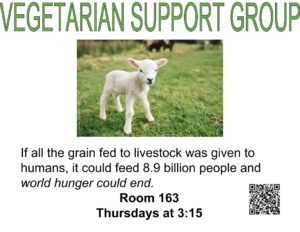
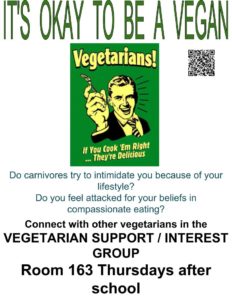
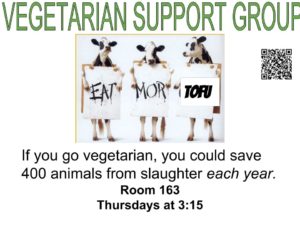
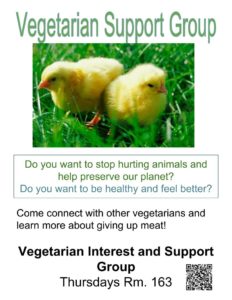
Add a QR code which students can scan to read more information. Don’t use graphic images like slaughterhouses, because these posters will probably be torn down quickly. Instead, present funny photos, catchy phrases, interesting facts, or yummy vegan recipes.
Where should I hang posters?
Near water fountains and bathrooms, where pretty much everyone stops by.
In the hallways on the way to the cafeteria, since people will already be hungry thinking about food when they see your posters.
In classrooms – ask teachers if you can hang a poster at the front of their room. Target
environmental science or biology classes, since they might talk about the impacts of animal agriculture.
What should we do as a club?
Here are some ideas for club activities:
Do a survey. Find out how many vegetarians are in your school, and what barriers prevent others from trying this diet. You can tailor your club outreach activities to help accommodate recurring challenges. Share the survey during homeroom sessions, in school-wide emails, and during announcements. Consider partnering with the Statistics or Environmental Science classes to conduct this survey.
Start a garden. Create a veganic garden, which doesn’t use animal-sourced fertilizers or pesticides. This is a great way to bond with club members, enjoy nature, help the environment, and grow vegan food yourself!
Have a poster designing contest. This can be open to the entire school to engage the rest of the community. If possible, offer a prize to the poster with the most votes. Remind participants to avoid graphic images. Don’t try to convert by disgust, but rather enlighten peers so that they can make their own informed decisions.
Make announcements about vegetarianism. Share statistics, exciting recipes, or other resources.
Host information sessions to share information about vegetarian diets. Provide pamphlets, coloring books, cookbooks, and other resources so people can find answers to their questions.
Recruit guest speakers. If you’re able to, reach out to dietitians who can answer questions about transitioning to and maintaining a meatless diet; local vegetarian group representatives; former meat industry employees; authors of cookbooks or vegetarian materials.
Host film screenings for students who want to watch documentaries about the agriculture industry.
Be supportive and share tips about how to maintain vegetarianism even in an environment that is often hostile to vegans/vegetarians.
Exchange recipes. Ask everyone to bring their favorite vegan recipe, or to modify a usually-non-vegetarian recipe to be delicious and compassionate. Encourage students to try vegetarianism.
Offer samples of vegan food. Reach out to local markets or retailers to see if they could offer samples to club members.
Have vegan bake sales. Prove to your classmates that vegan food can taste delicious! Plus, you can raise money for your club.
Design T-shirts. Have a t-shirt which invites classmates to ask you questions about your diet and can make peers excited about joining your club.
Lead Homeroom sessions. If your school allows you to, create a presentation to share with homeroom classes about the environmental impacts of agriculture; delicious vegan recipes; the history of the vegetarian movement; vegan celebrities; or ancient ethical arguments about food.
Remember, don’t try to convert by disgust; just educate and share the truth.
How can we get more vegetarian options in school lunches?
This is a complicated issue. Public school cafeterias are subject to very specific guidelines and regulations – so no matter how nicely you ask, your lunch staff can’t create a whole new menu. Still, have your club discuss more vegan options with the school foodservice. There is some flexibility for what is served, but don’t expect any sudden major overhaul – especially because schools are on a strict budget and are reimbursed just $1.80 per free meal. To learn more about federal school cafeteria guidelines, see https://www.gpo.gov/fdsys/pkg/FR-2012-01-26/pdf/2012-1010.pdf (especially pp. 16-17). Also see: https://www.vrg.org/fsupdate/index.htm#School and https://www.vrg.org/teen/#food
If student would buy non-dairy milks, you could start by asking for them to be offered in vending machines, if they can’t fit in the cafeteria menu.
What if no one comes to my club?
Don’t give up! Surely there is at least one other person who wants to learn more about vegetarianism. Continue your efforts, and work even harder! Make more announcements and ask to hang posters in teachers’ classrooms. Ask a friend what would be attractive to them, and try a new style of poster. Connect with related clubs and activities, like a Health Club, Cooking Club, Yoga and Meditation Club, Culture Clubs, or any other club you could share vegan recipes with. Try to work together.
What if people make fun of my club?
Remember why you became vegetarian/vegan in the first place. Use this to guide you even when following your beliefs feels challenging. Stick with your beliefs even if others aren’t respectful of them.
Don’t criticize non-vegetarians, just like you don’t want them to criticize you. Remember that people don’t like being told they are wrong, and they are often resistant to hearing the truth.
What if my classmates don’t live near grocery stores?
This is certainly a big barrier for some people who wish to be vegan. In Baltimore, for example, almost 1 in 4 residents live in “food deserts,” or areas with low median incomes and without access to adequate healthy food. Many inner-city families rely primarily on small corner stores, which often lack fresh produce, and consist mainly of canned, boxed, or otherwise over-processed foods. In a city, residents shouldn’t be expected to walk more than five minutes or a quarter mile to reach a grocery store, but supermarkets can be challenging to reach without a car. Sometimes, it is easier to find orange soda than to buy fresh oranges. Many inner-city students have immense barriers in front of them simply to eat healthfully, and even more to be vegetarian. Be mindful of this when suggesting recipes. Many students can’t find meat analogues or high-cost vegan products, such as vegan mayonnaise or veggie burgers, and usually can’t afford them. To accommodate this, you can share simple recipes using easily-accessible staples.
Suggest international recipes. These are often less expensive, and many neighborhoods offer ethnic foods stores even when supermarkets aren’t available. Staples like beans and rice last a long time, are inexpensive, and can be found in almost any culture’s cuisine!
Sample Club Constitution:
Vegetarian Support Group Club Constitution
The purpose of this club is to promote vegetarianism in the Baltimore Polytechnic Institute (“Poly”) community and to support students as they try to live by a vegetarian diet.
We will encourage Poly students to try out a vegetarian diet by displaying posters, making announcements, and offering information sessions to share information about plant-based diets.
We will help foster awareness about the benefits of vegetarianism and importance of sustainable living through film screenings, poster-making contests, and other events involving the Poly community. We will host events to offer samples of vegan food, exchange recipes, and encourage students to try vegetarianism. We will encourage one another and share tips about how we can maintain vegetarianism even in an environment that is often hostile to vegans/vegetarians.
We meet every Thursday in Room 163.
Our teacher advisor is Ms. Boose.




